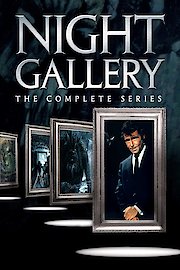In Rod Serling's Night Gallery, Season 1, Episode 11 titled "The Man Who Died At Three & Nine", viewers are taken on a chilling journey into the realms of the supernatural and the macabre. With its signature blend of horror and suspense, this episode presents two distinct stories that will leave audiences on the edge of their seats.
The first story, "The Man Who Died At Three," introduces us to Professor Peabody, an eccentric and enigmatic scholar known for his exceptional linguistic abilities. One day, the professor stumbles upon an ancient scroll that supposedly contains a curse. Intrigued, he begins translating the enigmatic text and discovers that its magic will cause him to die at three o'clock that same day. As the clock ticks closer to the fated hour, Peabody's paranoia and fear intensify. Is there any way to break the curse, or is his demise inevitable? This haunting tale showcases the tragic consequences of meddling with forces beyond our comprehension.
The second story, "The Man Who Died At Nine," tells the story of a troubled man named John Marriott. Haunted by his sordid past, Marriott has sought solace in a small town far away from civilization. However, his peace is shattered when he begins seeing the apparition of a young girl who seemingly drowned in a nearby lake years ago. The girl's ghostly appearances become increasingly frequent and menacing, leading Marriott to believe that she is seeking vengeance for her untimely demise. As he delves deeper into the chilling mystery surrounding the girl's death, Marriott unravels a nefarious secret lurking beneath the town's tranquil surface. This spine-tingling tale explores the horrors that can be found in the darkest corners of human existence.
"The Man Who Died At Three & Nine" is a captivating episode that exemplifies the brilliant storytelling and eerie atmospheres for which Night Gallery is renowned. With its imaginative plots, unexpected twists, and atmospheric visuals, this episode will keep viewers enthralled from start to finish. Rod Serling, the master of the macabre, weaves these tales with his signature style, effortlessly blending supernatural elements with gut-wrenching human drama.
As with each Night Gallery episode, "The Man Who Died At Three & Nine" includes an introspective framing story. This framework revolves around the enigmatic art gallery, where chilling paintings come to life, serving as gateways into the nightmarish narratives. Serling's intros provide thought-provoking musings on the human condition, giving viewers a brief respite before delving into the next bone-chilling tale.
The performances in this episode are exceptionally compelling, with a stellar cast bringing each character to life. Notably, the actors skillfully convey the emotional depths and psychological turmoil experienced by their respective roles. Their portrayals enhance the already gripping narratives, immersing viewers in a world where the line between reality and the supernatural is blurred.
Additionally, the production design and cinematography contribute to the overall eerie ambiance of the episode. From dimly lit interiors to haunting landscapes, every frame is meticulously crafted to evoke a sense of unease and foreboding. Combined with the haunting musical score, the visual and auditory elements work harmoniously to create an unforgettable viewing experience.
"The Man Who Died At Three & Nine" serves as a compelling showcase of Night Gallery's ability to delve into the darkest corners of the human psyche. With its thought-provoking stories, atmospheric visuals, and superb performances, this episode will leave viewers questioning their own beliefs and fears long after the credits roll. Step into the Night Gallery, and prepare to be enthralled by the mysterious and the macabre.
-
Genres
-
CastMichael ConstantineClint HowardJoseph Campanella
-
Channel
-
First AiredJanuary 1, 1969
-
Runtime50 min
-
LanguageEnglish
-
IMDB Rating7.4 (446)

-
 Watch Unlimited Prime Video TV Shows
Watch Unlimited Prime Video TV Shows
-
 Anytime, Anywhere
Anytime, Anywhere
-
 Ad-free Videos
Ad-free Videos


 Watch Unlimited Prime Video TV Shows
Watch Unlimited Prime Video TV Shows
 Anytime, Anywhere
Anytime, Anywhere
 Ad-free Videos
Ad-free Videos